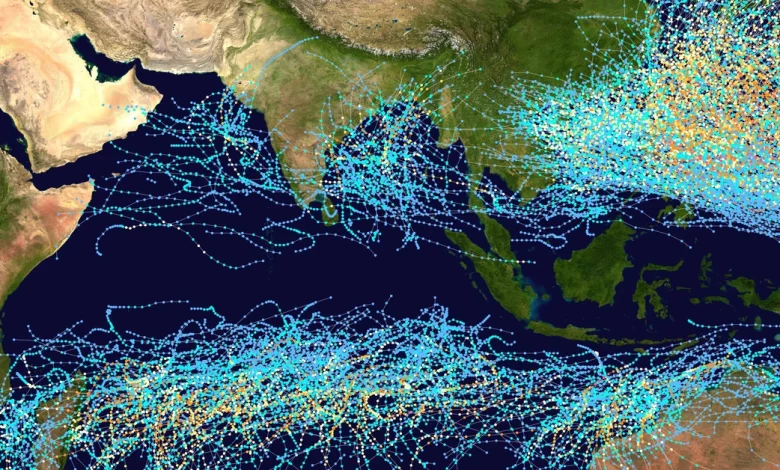Daily Current Affairs for UPSC
Changing Landscape of Cyclone Formation
Syllabus- Geography [GS Paper-1]

Context- A study recently published in the journal Climate and Atmospheric Science reports a sharp change in the likelihood of cyclone formation over the Arabian Sea in the late 1990s.
Key Highlights
- Climate scientists examine whether observed changes in climate variables, such as reduced monsoon rainfall, increased extreme rainfall, droughts, heat waves and cyclones, are trends, shifts or decades.
- These differences are important when planning resources such as water, plants and energy.
- A new study suggests a change in the cyclogenesis potential of the Arabian Sea, which may be linked to a change in the pattern of a warm Arctic and cold Eurasia.
- Global warming and changes in the system may also be involved.
- To better understand climate risks and plan for adaptation, scientists must study natural variability and how global warming is changing it.
Effect of climate change on the formation of cyclones:
- Increased Precipitation: A warmer atmosphere can absorb more moisture, leading to increased precipitation.
- Increased rainfall results in more heat being released, which ultimately encourages stronger winds within the cyclone.
- Recent studies have shown that hurricane rainfall increases by at least 7 percent for every degree of warming.
- Cyclone Intensification: A warming climate is expected to increase wind speeds, leading to more storms strengthening into Category 4 or 5 hurricanes / cyclones.
- Rising temperatures: Both ocean and atmospheric temperatures play a key role in the formation of tropical cyclones.
- Cyclonic storms are powered by heat released by the evaporation of ocean surface water and condensed as rain within the storm.
- In a warming climate, a warmer ocean increases evaporation, which in turn means more moisture in the atmosphere.
- Sea level rise: Rising temperatures increase sea level rise and increase the depth of stormwater runoff.
- As the sea level rises, the storm reaches deeper inland.
- Reduced Storm Speed: The speed of a cyclone can significantly affect the total amount of rain at a given location.
- Slower moving storms allow a longer time for precipitation to accumulate.
- Although research shows that the speed of the storm is slowing, the underlying mechanisms are still unclear.
- Storm Fusion: In an increasingly warming world, the convergence of two large tropical storms over any ocean in the world can cause the formation of a massive super cyclone.
Effects of the changing landscape of cyclones and its consequences:
- Increased destruction: Stronger storms can cause significantly more damage to both people and the economy.
- Cyclone Amphan hit eastern India and Bangladesh in May 2020.
- In India, the storm killed 98 people and more than 5,00,000 people were evacuated from Bengal and Odisha.
- Forecasts: The rapidly evolving nature of storms has made conventional forecasting methods unreliable.
- This unpredictability directly affected the ability to take adequate precautions.
- Increasing frequency of storms: The number of hurricanes that occur each year may change in the future.
- However, there is no universally accepted theory that fully explains the number of storms in the current climate or predicts how it might change in the future.
- Changing impact zones: Recent studies show that the areas where storms reach maximum intensity are gradually moving towards the Earth’s poles.
- This change has significant implications for the core areas of these storms.
- In 2021, Gujarat faced Cyclone Tauktae, the deadliest cyclone to hit the Arabian Sea in the last decade.
- According to reports, the gale force winds and rains have killed around 70 people and more than 8,000 livestock and damaged up to 88,000 homes.
- 2,80,000 people were evacuated from coastal areas.
- Climate scientists use different terms to describe observed changes in climate variables.
- These include;
- Trend: a trend means that a climate variable is constantly changing in one direction, such as a steady increase in temperature.
- The term “human-induced trend” indicates that these changes occur during a person’s lifetime, although the exact time frame over which a variable becomes a trend is not always clear.
- Secular trend: This term is used when a variable has increased or decreased over a long period of time.
- For example, a variable may have a secular trend if it has increased continuously for 30 years over a 100-year period.
- Decadal variability: Decadal variability refers to changes from positive phase to negative phase over decades.
- This is somewhat similar to the concept of change, but decadent variability is often cyclical.
- Transition: A transition represents a rapid transition from one state to another, such as a sudden change in precipitation or temperature.
- It can be an irreversible jump or a temporary change that later returns to its previous state.
About cyclones:
- The word cyclone is derived from the Greek word Cyclos, which means the coils of a snake.
- It was coined by Henry Peddington because tropical storms in the Bay of Bengal and the Arabian Sea look like coiled sea serpents.
- They are caused by atmospheric disturbances around an area of low pressure characterized by rapid and often destructive circulation of air.
- They are usually accompanied by violent storms and bad weather.
- Air circulates counterclockwise in the northern hemisphere and clockwise in the southern hemisphere.
The way forward:
- Therefore, a study highlighting changes in the potential for cyclone formation in the Arabian Sea in the late 1990s is a compelling example of the complex interaction between climate patterns and regional climate phenomena.
- This highlights the importance of distinguishing between trends, changes and decay cycles in climate research and their implications for resource planning and climate adaptation.
Source: The Hindu
Practice question:
Q. Shed light on the formation of cyclone.





.png)



